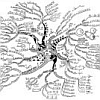| |
    
Richard C. Winkworth,
David Bryant,
Peter J. Lockhart,
David Havell and
Vincent Moulton. Biogeographic Interpretation of Splits Graphs: Least Squares Optimization of Branch Lengths. In Systematic Biology, Vol. 54(1):56-65, 2005.
Keywords: abstract network, from distances, from network, phylogenetic network, phylogeny, reconstruction, split, split network.
Note: http://www.math.auckland.ac.nz/~bryant/Papers/05Biogeographic.pdf.
|
|
| |
|
| |
|
| |
   
Iyad A. Kanj,
Luay Nakhleh,
Cuong Than and
Ge Xia. Seeing the Trees and Their Branches in the Network is Hard. In TCS, Vol. 401:153-164, 2008.
Keywords: evaluation, from network, from rooted trees, NP complete, phylogenetic network, phylogeny, tree containment.
Note: http://www.cs.rice.edu/~nakhleh/Papers/tcs08.pdf.
|
|
| |
  
Bin Ma,
Lusheng Wang and
Ming Li. Fixed topology alignment with recombination. In DAM, Vol. 104:281-300, 2000.
Keywords: approximation, explicit network, from network, from sequences, galled tree, inapproximability, phylogenetic network, phylogeny, recombination.
Note: http://citeseerx.ist.psu.edu/viewdoc/summary?doi=10.1.1.40.7759.
Toggle abstract
"Background: Reticulate events play an important role in determining evolutionary relationships. The problem of computing the minimum number of such events to explain discordance between two phylogenetic trees is a hard computational problem. Even for binary trees, exact solvers struggle to solve instances with reticulation number larger than 40-50.Results: Here we present CycleKiller and NonbinaryCycleKiller, the first methods to produce solutions verifiably close to optimality for instances with hundreds or even thousands of reticulations.Conclusions: Using simulations, we demonstrate that these algorithms run quickly for large and difficult instances, producing solutions that are very close to optimality. As a spin-off from our simulations we also present TerminusEst, which is the fastest exact method currently available that can handle nonbinary trees: this is used to measure the accuracy of the NonbinaryCycleKiller algorithm. All three methods are based on extensions of previous theoretical work (SIDMA 26(4):1635-1656, TCBB 10(1):18-25, SIDMA 28(1):49-66) and are publicly available. We also apply our methods to real data. © 2014 van Iersel et al.; licensee BioMed Central Ltd."
|
|
| |
   
Gabriel Cardona,
Mercè Llabrés,
Francesc Rosselló and
Gabriel Valiente. The comparison of tree-sibling time consistent phylogenetic networks is graph-isomorphism complete. In The Scientific World Journal, Vol. 2014(254279):1-6, 2014.
Keywords: abstract network, distance between networks, from network, isomorphism, phylogenetic network, tree sibling network.
Note: http://arxiv.org/abs/0902.4640.
Toggle abstract
"Several polynomial time computable metrics on the class of semibinary tree-sibling time consistent phylogenetic networks are available in the literature; in particular, the problem of deciding if two networks of this kind are isomorphic is in P. In this paper, we show that if we remove the semibinarity condition, then the problem becomes much harder. More precisely, we prove that the isomorphism problem for generic tree-sibling time consistent phylogenetic networks is polynomially equivalent to the graph isomorphism problem. Since the latter is believed not to belong to P, the chances are that it is impossible to define a metric on the class of all tree-sibling time consistent phylogenetic networks that can be computed in polynomial time. © 2014 Gabriel Cardona et al."
|
|
| |

Stephen J. Willson. CSD Homomorphisms Between Phylogenetic Networks. In TCBB, Vol. 9(4), 2012.
Keywords: explicit network, from network, from quartets, phylogenetic network.
Note: http://www.public.iastate.edu/~swillson/Relationships11IEEE.pdf, preliminary version entitled Relationships Among Phylogenetic Networks.
Toggle abstract
"Since Darwin, species trees have been used as a simplified description of the relationships which summarize the complicated network N of reality. Recent evidence of hybridization and lateral gene transfer, however, suggest that there are situations where trees are inadequate. Consequently it is important to determine properties that characterize networks closely related to N and possibly more complicated than trees but lacking the full complexity of N. A connected surjective digraph map (CSD) is a map f from one network N to another network M such that every arc is either collapsed to a single vertex or is taken to an arc, such that f is surjective, and such that the inverse image of a vertex is always connected. CSD maps are shown to behave well under composition. It is proved that if there is a CSD map from N to M, then there is a way to lift an undirected version of M into N, often with added resolution. A CSD map from N to M puts strong constraints on N. In general, it may be useful to study classes of networks such that, for any N, there exists a CSD map from N to some standard member of that class. © 2012 IEEE."
|
|
| |

Stephen J. Willson. Restricted trees: simplifying networks with bottlenecks. In BMB, Vol. 73(10):2322-2338, 2011.
Keywords: from network, phylogenetic network.
Note: http://arxiv.org/abs/1005.4956.
Toggle abstract
"Suppose N is a phylogenetic network indicating a complicated relationship among individuals and taxa. Often of interest is a much simpler network, for example, a species tree T, that summarizes the most fundamental relationships. The meaning of a species tree is made more complicated by the recent discovery of the importance of hybridizations and lateral gene transfers. Hence, it is desirable to describe uniform well-defined procedures that yield a tree given a network N. A useful tool toward this end is a connected surjective digraph (CSD) map φ:N→N′ where N′ is generally a much simpler network than N. A set W of vertices in N is "restricted" if there is at most one vertex u∉W from which there is an arc into W, thus yielding a bottleneck in N. A CSD map φ:N→N′ is "restricted" if the inverse image of each vertex in N′ is restricted in N. This paper describes a uniform procedure that, given a network N, yields a well-defined tree called the "restricted tree" of N. There is a restricted CSD map from N to the restricted tree. Many relationships in the tree can be proved to appear also in N. © 2011 The Author(s)."
|
|
| |
  
Leo van Iersel,
Charles Semple and
Mike Steel. Locating a tree in a phylogenetic network. In IPL, Vol. 110(23), 2010.
Keywords: cluster containment, explicit network, from network, level k phylogenetic network, normal network, NP complete, phylogenetic network, polynomial, regular network, time consistent network, tree containment, tree sibling network, tree-child network.
Note: http://arxiv.org/abs/1006.3122.
Toggle abstract
"Phylogenetic trees and networks are leaf-labelled graphs that are used to describe evolutionary histories of species. The Tree Containment problem asks whether a given phylogenetic tree is embedded in a given phylogenetic network. Given a phylogenetic network and a cluster of species, the Cluster Containment problem asks whether the given cluster is a cluster of some phylogenetic tree embedded in the network. Both problems are known to be NP-complete in general. In this article, we consider the restriction of these problems to several well-studied classes of phylogenetic networks. We show that Tree Containment is polynomial-time solvable for normal networks, for binary tree-child networks, and for level-k networks. On the other hand, we show that, even for tree-sibling, time-consistent, regular networks, both Tree Containment and Cluster Containment remain NP-complete. © 2010 Elsevier B.V. All rights reserved."
|
|
| |

Chen Meng and
Laura S. Kubatko. Detecting hybrid speciation in the presence of incomplete lineage sorting using gene tree incongruence: A model. In Theoretical Population Biology, Vol. 75(1):35-45, 2009.
Keywords: bayesian, coalescent, from network, from rooted trees, hybridization, likelihood, lineage sorting, phylogenetic network, phylogeny, statistical model.
Note: http://dx.doi.org/10.1016/j.tpb.2008.10.004.
Toggle abstract
"The application of phylogenetic inference methods, to data for a set of independent genes sampled randomly throughout the genome, often results in substantial incongruence in the single-gene phylogenetic estimates. Among the processes known to produce discord between single-gene phylogenies, two of the best studied in a phylogenetic context are hybridization and incomplete lineage sorting. Much recent attention has focused on the development of methods for estimating species phylogenies in the presence of incomplete lineage sorting, but phylogenetic models that allow for hybridization have been more limited. Here we propose a model that allows incongruence in single-gene phylogenies to be due to both hybridization and incomplete lineage sorting, with the goal of determining the contribution of hybridization to observed gene tree incongruence in the presence of incomplete lineage sorting. Using our model, we propose methods for estimating the extent of the role of hybridization in both a likelihood and a Bayesian framework. The performance of our methods is examined using both simulated and empirical data. © 2008 Elsevier Inc. All rights reserved."
|
|
| |
  
Bui Quang Minh,
Steffen Klaere and
Arndt von Haeseler. Taxon Selection under Split Diversity. In Systematic Biology, Vol. 58(6):586-594, 2009.
Keywords: abstract network, circular split system, diversity, from network, phylogenetic network, split network.
Note: http://dx.doi.org/10.1093/sysbio/syp058.
Toggle abstract
"The phylogenetic diversity (PD) measure of biodiversity is evaluated using a phylogenetic tree, usually inferred from morphological or molecular data. Consequently, it is vulnerable to errors in that tree, including those resulting from sampling error, model misspecification, or conflicting signals. To improve the robustness of PD, we can evaluate the measure using either a collection (or distribution) of trees or a phylogenetic network. Recently, it has been shown that these 2 approaches are equivalent but that the problem of maximizing PD in the general concept is NP-hard. In this study, we provide an efficient dynamic programming algorithm for maximizing PD when splits in the trees or network form a circular split system. We illustrate our method using a case study of game birds (Galliformes) and discuss the different choices of taxa based on our approach and PD."
|
|
| |
   
Bui Quang Minh,
Fabio Pardi,
Steffen Klaere and
Arndt von Haeseler. Budgeted Phylogenetic Diversity on Circular Split Systems. In TCBB, Vol. 6(1):22-29, 2009.
Keywords: abstract network, circular split system, dynamic programming, from network, phylogenetic network, polynomial, split, split network.
Note: http://dx.doi.org/10.1109/TCBB.2008.54.
Toggle abstract
"In the last 15 years, Phylogenetic Diversity (PD) has gained interest in the community of conservation biologists as a surrogate measure for assessing biodiversity. We have recently proposed two approaches to select taxa for maximizing PD, namely PD with budget constraints and PD on split systems. In this paper, we will unify these two strategies and present a dynamic programming algorithm to solve the unified framework of selecting taxa with maximal PD under budget constraints on circular split systems. An improved algorithm will also be given if the underlying split system is a tree. © 2006 IEEE."
|
|
| |

Stephen J. Willson. Tree-average distances on certain phylogenetic networks have their weights uniquely determined. In ALMOB, Vol. 7(13), 2012.
Keywords: from distances, from network, normal network, phylogenetic network, phylogeny, reconstruction, tree-child network.
Note: hhttp://www.public.iastate.edu/~swillson/Tree-AverageDis10All.pdf.
Toggle abstract
"A phylogenetic network N has vertices corresponding to species and arcs corresponding to direct genetic inheritance from the species at the tail to the species at the head. Measurements of DNA are often made on species in the leaf set, and one seeks to infer properties of the network, possibly including the graph itself. In the case of phylogenetic trees, distances between extant species are frequently used to infer the phylogenetic trees by methods such as neighbor-joining.This paper proposes a tree-average distance for networks more general than trees. The notion requires a weight on each arc measuring the genetic change along the arc. For each displayed tree the distance between two leaves is the sum of the weights along the path joining them. At a hybrid vertex, each character is inherited from one of its parents. We will assume that for each hybrid there is a probability that the inheritance of a character is from a specified parent. Assume that the inheritance events at different hybrids are independent. Then for each displayed tree there will be a probability that the inheritance of a given character follows the tree; this probability may be interpreted as the probability of the tree. The tree-average distance between the leaves is defined to be the expected value of their distance in the displayed trees.For a class of rooted networks that includes rooted trees, it is shown that the weights and the probabilities at each hybrid vertex can be calculated given the network and the tree-average distances between the leaves. Hence these weights and probabilities are uniquely determined. The hypotheses on the networks include that hybrid vertices have indegree exactly 2 and that vertices that are not leaves have a tree-child. © 2012 Willson; licensee BioMed Central Ltd."
|
|
| |
    
Bonnie Kirkpatrick,
Yakir Reshef,
Hilary Finucane,
Haitao Jiang,
Binhai Zhu and
Richard M. Karp. Comparing Pedigree Graphs. In JCB, Vol. 19(9):998-1014, 2012.
Keywords: distance between networks, from network, pedigree.
Note: http://arxiv.org/abs/1009.0909, preliminary version as poster at WABI 2010.
Toggle abstract
"Pedigree graphs, or family trees, are typically constructed by an expensive process of examining genealogical records to determine which pairs of individuals are parent and child. New methods to automate this process take as input genetic data from a set of extant individuals and reconstruct ancestral individuals. There is a great need to evaluate the quality of these methods by comparing the estimated pedigree to the true pedigree. In this article, we consider two main pedigree comparison problems. The first is the pedigree isomorphism problem, for which we present a linear-time algorithm for leaf-labeled pedigrees. The second is the pedigree edit distance problem, for which we present (1) several algorithms that are fast and exact in various special cases, and (2) a general, randomized heuristic algorithm. In the negative direction, we first prove that the pedigree isomorphism problem is as hard as the general graph isomorphism problem, and that the sub-pedigree isomorphism problem is NP-hard. We then show that the pedigree edit distance problem is APX-hard in general and NP-hard on leaf-labeled pedigrees. We use simulated pedigrees to compare our edit-distance algorithms to each other as well as to a branch-and-bound algorithm that always finds an optimal solution. © 2012, Mary Ann Liebert, Inc."
|
|
| |
   
Mareike Fischer,
Leo van Iersel,
Steven Kelk and
Celine Scornavacca. On Computing The Maximum Parsimony Score Of A Phylogenetic Network. In SIDMA, Vol. 29(1):559-585, 2015.
Keywords: APX hard, cluster containment, explicit network, FPT, from network, from sequences, integer linear programming, level k phylogenetic network, NP complete, parsimony, phylogenetic network, phylogeny, polynomial, Program MPNet, reconstruction, software.
Note: http://arxiv.org/abs/1302.2430.
|
|
| |
|
| |
  
Yun Yu,
R. Matthew Barnett and
Luay Nakhleh. Parsimonious Inference of Hybridization in the Presence of Incomplete Lineage Sorting. In Systematic Biology, Vol. 62(5):738-751, 2013.
Keywords: from network, from rooted trees, hybridization, lineage sorting, parsimony, phylogenetic network, phylogeny, Program PhyloNet, reconstruction.
Toggle abstract
"Hybridization plays an important evolutionary role in several groups of organisms. A phylogenetic approach to detect hybridization entails sequencing multiple loci across the genomes of a group of species of interest, reconstructing their gene trees, and taking their differences as indicators of hybridization. However, methods that follow this approach mostly ignore population effects, such as incomplete lineage sorting (ILS). Given that hybridization occurs between closely related organisms, ILS may very well be at play and, hence, must be accounted for in the analysis framework. To address this issue, we present a parsimony criterion for reconciling gene trees within the branches of a phylogenetic network, and a local search heuristic for inferring phylogenetic networks from collections of gene-tree topologies under this criterion. This framework enables phylogenetic analyses while accounting for both hybridization and ILS. Further, we propose two techniques for incorporating information about uncertainty in gene-tree estimates. Our simulation studies demonstrate the good performance of our framework in terms of identifying the location of hybridization events, as well as estimating the proportions of genes that underwent hybridization. Also, our framework shows good performance in terms of efficiency on handling large data sets in our experiments. Further, in analysing a yeast data set, we demonstrate issues that arise when analysing real data sets. Although a probabilistic approach was recently introduced for this problem, and although parsimonious reconciliations have accuracy issues under certain settings, our parsimony framework provides a much more computationally efficient technique for this type of analysis. Our framework now allows for genome-wide scans for hybridization, while also accounting for ILS. [Phylogenetic networks; hybridization; incomplete lineage sorting; coalescent; multi-labeled trees.] © 2013 The Author(s). All rights reserved."
|
|
| |
  
Celine Scornavacca,
Paprotny Wojciech,
Vincent Berry and
Vincent Ranwez. Representing a set of reconciliations in a compact way. In JBCB, Vol. 11(2):1250025, 2013.
Keywords: duplication, explicit network, from network, from rooted trees, from species tree, phylogeny, Program GraphDTL, Program TERA, visualization.
Note: http://hal-lirmm.ccsd.cnrs.fr/lirmm-00818801.
Toggle abstract
"Comparative genomic studies are often conducted by reconciliation analyses comparing gene and species trees. One of the issues with reconciliation approaches is that an exponential number of optimal scenarios is possible. The resulting complexity is masked by the fact that a majority of reconciliation software pick up a random optimal solution that is returned to the end-user. However, the alternative solutions should not be ignored since they tell different stories that parsimony considers as viable as the output solution. In this paper, we describe a polynomial space and time algorithm to build a minimum reconciliation graph-a graph that summarizes the set of all most parsimonious reconciliations. Amongst numerous applications, it is shown how this graph allows counting the number of non-equivalent most parsimonious reconciliations. © 2013 Imperial College Press."
|
|
| |
 
Jesper Jansson and
Andrzej Lingas. Computing the rooted triplet distance between galled trees by counting triangles. In Journal of Discrete Algorithms, Vol. 25:66-78, 2014.
Keywords: distance between networks, explicit network, from network, galled network, phylogenetic network, phylogeny, polynomial, triplet distance.
Toggle abstract
"We consider a generalization of the rooted triplet distance between two phylogenetic trees to two phylogenetic networks. We show that if each of the two given phylogenetic networks is a so-called galled tree with n leaves then the rooted triplet distance can be computed in o(n2.687) time. Our upper bound is obtained by reducing the problem of computing the rooted triplet distance between two galled trees to that of counting monochromatic and almost-monochromatic triangles in an undirected, edge-colored graph. To count different types of colored triangles in a graph efficiently, we extend an existing technique based on matrix multiplication and obtain several new algorithmic results that may be of independent interest: (i) the number of triangles in a connected, undirected, uncolored graph with m edges can be computed in o(m1.408) time; (ii) if G is a connected, undirected, edge-colored graph with n vertices and C is a subset of the set of edge colors then the number of monochromatic triangles of G with colors in C can be computed in o(n2.687) time; and (iii) if G is a connected, undirected, edge-colored graph with n vertices and R is a binary relation on the colors that is computable in O(1) time then the number of R-chromatic triangles in G can be computed in o(n2.687) time. © 2013 Elsevier B.V. All rights reserved."
|
|
| |

Ward C Wheeler. Phyletic groups on networks. In Cladistics, Vol. 30(4):447-451, 2014.
Keywords: explicit network, from network, phylogenetic network, phylogeny.
Note: http://dx.doi.org/10.1111/cla.12062.
Toggle abstract
"Three additional phyletic group types, "periphyletic," "epiphyletic", and "anaphyletic" (in addition to Hennigian mono-, para-, and polyphyletic) are defined in terms of trees and phylogenetic networks (trees with directed reticulate edges) via a generalization of the algorithmic definitions of Farris. These designations concern groups defined as monophyletic on trees, but with additional gains or losses of members from network edges. These distinctions should be useful in discussion of systems with non-vertical inheritance such as recombination between viruses, horizontal exchange between bacteria, hybridization in plants and animals, as well as human linguistic evolution. Examples are illustrated with Indo-European language groups. © The Willi Hennig Society 2013."
|
|
| |
 
Lavanya Kannan and
Ward C Wheeler. Exactly Computing the Parsimony Scores on Phylogenetic Networks Using Dynamic Programming. In JCB, Vol. 21(4):303-319, 2014.
Keywords: explicit network, exponential algorithm, from network, from sequences, parsimony, phylogenetic network, phylogeny, reconstruction.
Toggle abstract
"Scoring a given phylogenetic network is the first step that is required in searching for the best evolutionary framework for a given dataset. Using the principle of maximum parsimony, we can score phylogenetic networks based on the minimum number of state changes across a subset of edges of the network for each character that are required for a given set of characters to realize the input states at the leaves of the networks. Two such subsets of edges of networks are interesting in light of studying evolutionary histories of datasets: (i) the set of all edges of the network, and (ii) the set of all edges of a spanning tree that minimizes the score. The problems of finding the parsimony scores under these two criteria define slightly different mathematical problems that are both NP-hard. In this article, we show that both problems, with scores generalized to adding substitution costs between states on the endpoints of the edges, can be solved exactly using dynamic programming. We show that our algorithms require O(mpk) storage at each vertex (per character), where k is the number of states the character can take, p is the number of reticulate vertices in the network, m = k for the problem with edge set (i), and m = 2 for the problem with edge set (ii). This establishes an O(nmpk2) algorithm for both the problems (n is the number of leaves in the network), which are extensions of Sankoff's algorithm for finding the parsimony scores for phylogenetic trees. We will discuss improvements in the complexities and show that for phylogenetic networks whose underlying undirected graphs have disjoint cycles, the storage at each vertex can be reduced to O(mk), thus making the algorithm polynomial for this class of networks. We will present some properties of the two approaches and guidance on choosing between the criteria, as well as traverse through the network space using either of the definitions. We show that our methodology provides an effective means to study a wide variety of datasets. © Copyright 2014, Mary Ann Liebert, Inc. 2014."
|
|
| |
    
Kevin J. Liu,
Jingxuan Dai,
Kathy Truong,
Ying Song,
Michael H. Kohn and
Luay Nakhleh. An HMM-Based Comparative Genomic Framework for Detecting Introgression in Eukaryotes. In PLoS ONE, Vol. 10(6):e1003649, 2014.
Keywords: explicit network, from network, phylogenetic network, phylogeny, Program PhyloNet-HMM.
Note: http://arxiv.org/abs/1310.7989.
Toggle abstract
"One outcome of interspecific hybridization and subsequent effects of evolutionary forces is introgression, which is the integration of genetic material from one species into the genome of an individual in another species. The evolution of several groups of eukaryotic species has involved hybridization, and cases of adaptation through introgression have been already established. In this work, we report on PhyloNet-HMM-a new comparative genomic framework for detecting introgression in genomes. PhyloNet-HMM combines phylogenetic networks with hidden Markov models (HMMs) to simultaneously capture the (potentially reticulate) evolutionary history of the genomes and dependencies within genomes. A novel aspect of our work is that it also accounts for incomplete lineage sorting and dependence across loci. Application of our model to variation data from chromosome 7 in the mouse (Mus musculus domesticus) genome detected a recently reported adaptive introgression event involving the rodent poison resistance gene Vkorc1, in addition to other newly detected introgressed genomic regions. Based on our analysis, it is estimated that about 9% of all sites within chromosome 7 are of introgressive origin (these cover about 13 Mbp of chromosome 7, and over 300 genes). Further, our model detected no introgression in a negative control data set. We also found that our model accurately detected introgression and other evolutionary processes from synthetic data sets simulated under the coalescent model with recombination, isolation, and migration. Our work provides a powerful framework for systematic analysis of introgression while simultaneously accounting for dependence across sites, point mutations, recombination, and ancestral polymorphism. © 2014 Liu et al."
|
|
| |
   
Katharina Huber,
Leo van Iersel,
Vincent Moulton and
Taoyang Wu. How much information is needed to infer reticulate evolutionary histories? In Systematic Biology, Vol. 64(1):102-111, 2015.
Keywords: explicit network, from network, from rooted trees, from subnetworks, from trinets, identifiability, phylogenetic network, phylogeny, reconstruction, uniqueness.
Note: http://dx.doi.org/10.1093/sysbio/syu076.
|
|
| |
|
| |
|
| |
  
Sha Zhu,
James H. Degnan,
Sharyn J. Goldstein and
Bjarki Eldon. Hybrid-Lambda: simulation of multiple merger and Kingman gene genealogies in species networks and species trees. In BMCB, Vol. 16(292):1-7, 2015.
Keywords: explicit network, from network, phylogenetic network, phylogeny, Program Hybrid-Lambda, simulation, software.
Note: http://dx.doi.org/10.1186/s12859-015-0721-y.
|
|
| |
    
Philippe Gambette,
Leo van Iersel,
Steven Kelk,
Fabio Pardi and
Celine Scornavacca. Do branch lengths help to locate a tree in a phylogenetic network? In BMB, Vol. 78(9):1773-1795, 2016.
Keywords: branch length, explicit network, FPT, from network, from rooted trees, NP complete, phylogenetic network, phylogeny, pseudo-polynomial, time consistent network, tree containment, tree sibling network.
Note: http://arxiv.org/abs/1607.06285.
|
|
| |
   
Leo van Iersel,
Steven Kelk,
Giorgios Stamoulis,
Leen Stougie and
Olivier Boes. On unrooted and root-uncertain variants of several well-known phylogenetic network problems. In ALG, Vol. 80(11):2993-3022, 2018.
Keywords: explicit network, FPT, from network, from unrooted trees, NP complete, phylogenetic network, phylogeny, reconstruction, tree containment.
Note: https://hal.inria.fr/hal-01599716.
|
|
| |
 
Sha Zhu and
James H. Degnan. Displayed Trees Do Not Determine Distinguishability Under the Network Multispecies Coalescent. In SB, Vol. 66(2):283-298, 2017.
Keywords: branch length, coalescent, explicit network, from network, likelihood, phylogenetic network, phylogeny, Program Hybrid-coal, Program Hybrid-Lambda, Program PhyloNet, software, uniqueness.
Note: presentation available at https://www.youtube.com/watch?v=JLYGTfEZG7g.
|
|
| |
  
Andreas Gunawan,
Bhaskar DasGupta and
Louxin Zhang. A decomposition theorem and two algorithms for reticulation-visible networks. In Information and Computation, Vol. 252:161-175, 2017.
Keywords: cluster containment, explicit network, from clusters, from network, from rooted trees, phylogenetic network, phylogeny, polynomial, reticulation-visible network, tree containment.
Note: https://www.cs.uic.edu/~dasgupta/resume/publ/papers/Infor_Comput_IC4848_final.pdf.
|
|
| |
   
Andrew R. Francis,
Katharina Huber,
Vincent Moulton and
Taoyang Wu. Bounds for phylogenetic network space metrics. In JOMB, Vol. 76(5):1229-1248, 2018.
Keywords: bound, distance between networks, from network, NNI distance, NNI moves, phylogenetic network, phylogeny, SPR distance, TBR distance.
Note: https://arxiv.org/abs/1702.05609.
|
|
| |
|
| |
  
Celine Scornavacca,
Joan Carles Pons and
Gabriel Cardona. Fast algorithm for the reconciliation of gene trees and LGT networks. In JTB, Vol. 418:129-137, 2017.
Keywords: duplication, explicit network, from network, from rooted trees, lateral gene transfer, LGT network, loss, parsimony, phylogenetic network, phylogeny, polynomial, reconstruction.
|
|
| |
    
Philippe Gambette,
Andreas Gunawan,
Anthony Labarre,
Stéphane Vialette and
Louxin Zhang. Solving the Tree Containment Problem in Linear Time for Nearly Stable Phylogenetic Networks. In DAM, Vol. 246:62-79, 2018.
Keywords: explicit network, from network, from rooted trees, nearly-stable network, phylogenetic network, phylogeny, polynomial, tree containment.
Note: https://hal-upec-upem.archives-ouvertes.fr/hal-01575001/en/.
|
|
| |
     
Philippe Gambette,
Leo van Iersel,
Mark Jones,
Manuel Lafond,
Fabio Pardi and
Celine Scornavacca. Rearrangement Moves on Rooted Phylogenetic Networks. In PLoS Computational Biology, Vol. 13(8):e1005611.1-21, 2017.
Keywords: distance between networks, explicit network, from network, NNI distance, NNI moves, phylogenetic network, phylogeny, SPR distance.
Note: https://hal-upec-upem.archives-ouvertes.fr/hal-01572624/en/.
|
|
| |
|
| |
|
| |
    
Remie Janssen,
Mark Jones,
Péter L. Erdös,
Leo van Iersel and
Celine Scornavacca. Exploring the tiers of rooted phylogenetic network space using tail moves. In BMB, Vol. 80(8):2177-2208, 2018.
Keywords: distance between networks, explicit network, from network, NNI moves, orientation, phylogenetic network, phylogeny, SPR distance.
Note: https://arxiv.org/abs/1708.07656.
|
|
| |
  
Joan Carles Pons,
Charles Semple and
Mike Steel. Tree-based networks: characterisations, metrics, and support trees. In JOMB, Vol. 78(4):899-918, 2019.
Keywords: characterization, explicit network, from network, phylogenetic network, phylogeny, time consistent network, tree-based network.
Note: https://arxiv.org/abs/1710.07836.
|
|
| |
  
Paul Bastide,
Claudia Solís-Lemus,
Ricardo Kriebel,
Kenneth William Sparks and
Cécile Ané. Phylogenetic Comparative Methods on Phylogenetic Networks with Reticulations. In SB, Vol. 67(5):800-820, 2018.
Keywords: ancestral trait reconstruction, from network, likelihood, Program PhyloNetworks SNaQ, software, statistical model, statistical test.
Note: https://doi.org/10.1101/194050.
|
|
| |
|
| |
   
Klaus Schliep,
Alastair J. Potts,
David A. Morrison and
Guido W. Grimm. Intertwining phylogenetic trees and networks. In Methods in Ecology and Evolution, Vol. 8(10):1212-1220, 2017.
Keywords: abstract network, from network, from unrooted trees, phylogenetic network, phylogeny, split network, visualization.
Note: http://dx.doi.org/10.1111/2041-210X.12760.
|
|
| |
|
| |
|
| |
|
| |
 
Juan Wang and
Maozu Guo. A review of metrics measuring dissimilarity for rooted phylogenetic networks. In Briefings in Bioinformatics, Vol. 20(6):1972-1980, 2019.
Keywords: distance between networks, explicit network, from network, mu distance, phylogenetic network, phylogeny, survey, tree sibling network, tree-child network.
|
|
| |
|
|
|
| |
|
| |
 
Luay Nakhleh and
Li-San Wang. Phylogenetic Networks, Trees, and Clusters. In IWBRA05, Vol. 3515:919-926 of LNCS, springer, 2005.
Keywords: cluster containment, evaluation, from clusters, from network, from rooted trees, phylogenetic network, phylogeny, polynomial, tree containment, tree-child network.
Note: http://www.cs.rice.edu/~nakhleh/Papers/NakhlehWang.pdf.
|
|
| |
 
Luay Nakhleh and
Li-San Wang. Phylogenetic Networks: Properties and Relationship to Trees and Clusters. In TCSB2, Vol. 3680:82-99 of LNCS, springer, 2005.
Keywords: cluster containment, evaluation, from clusters, from network, from rooted trees, phylogenetic network, phylogeny, polynomial, tree containment, tree-child network.
Note: http://www.cs.rice.edu/~nakhleh/Papers/LNCS_TCSB05.pdf.
|
|
| |
  
Bin Ma,
Lusheng Wang and
Ming Li. Fixed topology alignment with recombination. In CPM98, Vol. 1448:174-188 of LNCS, springer, 1998.
Keywords: approximation, explicit network, from network, from sequences, galled tree, inapproximability, phylogenetic network, phylogeny, recombination.
Note: http://dx.doi.org/10.1007/BFb0030789.
|
|
| |
 
Celine Scornavacca,
Franziska Zickmann and
Daniel H. Huson. Tanglegrams for Rooted Phylogenetic Trees and Networks. In ISMB11, Vol. 27(13):i248-i256 of BIO, 2011.
Keywords: from network, heuristic, integer linear programming, phylogenetic network, phylogeny, Program Dendroscope, tanglegram, visualization.
Note: http://dx.doi.org/10.1093/bioinformatics/btr210.
Toggle abstract
"Motivation: In systematic biology, one is often faced with the task of comparing different phylogenetic trees, in particular in multi-gene analysis or cospeciation studies. One approach is to use a tanglegram in which two rooted phylogenetic trees are drawn opposite each other, using auxiliary lines to connect matching taxa. There is an increasing interest in using rooted phylogenetic networks to represent evolutionary history, so as to explicitly represent reticulate events, such as horizontal gene transfer, hybridization or reassortment. Thus, the question arises how to define and compute a tanglegram for such networks. Results: In this article, we present the first formal definition of a tanglegram for rooted phylogenetic networks and present a heuristic approach for computing one, called the NN-tanglegram method. We compare the performance of our method with existing tree tanglegram algorithms and also show a typical application to real biological datasets. For maximum usability, the algorithm does not require that the trees or networks are bifurcating or bicombining, or that they are on identical taxon sets. © The Author(s) 2011. Published by Oxford University Press."
|
|
| |
|
| |
 
Jesper Jansson and
Andrzej Lingas. Computing the rooted triplet distance between galled trees by counting triangles. In CPM12, Vol. 7354:385-398 of LNCS, springer, 2012.
Keywords: distance between networks, explicit network, from network, galled tree, phylogenetic network, phylogeny, polynomial, triplet distance.
Note: http://www.df.lth.se/~jj/Publications/d_rt_for_Galled_Trees5_CPM_2012.pdf.
Toggle abstract
"We consider a generalization of the rooted triplet distance between two phylogenetic trees to two phylogenetic networks. We show that if each of the two given phylogenetic networks is a so-called galled tree with n leaves then the rooted triplet distance can be computed in o(n 2.688) time. Our upper bound is obtained by reducing the problem of computing the rooted triplet distance to that of counting monochromatic and almost- monochromatic triangles in an undirected, edge-colored graph. To count different types of colored triangles in a graph efficiently, we extend an existing technique based on matrix multiplication and obtain several new related results that may be of independent interest. © 2012 Springer-Verlag."
|
|
| |
|
| |
   
Louxin Zhang,
Yen Kaow Ng,
Taoyang Wu and
Yu Zheng. Network model and efficient method for detecting relative duplications or horizontal gene transfers. In ICCABS11, Pages 214-219, 2011.
Keywords: dynamic programming, explicit network, from network, from rooted trees, from species tree, phylogenetic network, phylogeny, polynomial, reconstruction.
Toggle abstract
"Background: Horizontal gene transfer and gene duplication are two significant forces behind genome evolution. As more and more well-supported examples of HGTs are being revealed, there is a growing awareness that HGT is more widespread than previously thought, occurring often not only within bacteria, but also between species remotely related such as bacteria and plants or plants and animals. Although a substantial number of genomic sequences are known, HGT inference remains challenging. Parsimony-based inferences of HGT events are typically NP-hard under the framework of gene tree and species tree comparison; it is even more timeconsuming if the maximum likelihood approach is used. The fact that gene tree and species tree incongruence can be further confounded by gene duplication and gene loss events motivates us to incorporate considerations for these events into our inference of HGT events. Similarly, it will be beneficial if known HGT events are considered in the inference of gene duplications and gene losses. © 2011 IEEE."
|
|
| |
    
Philippe Gambette,
Andreas Gunawan,
Anthony Labarre,
Stéphane Vialette and
Louxin Zhang. Locating a Tree in A Phylogenetic Network in Quadratic Time. In RECOMB15, Vol. 9029:96-107 of LNCS, Springer, 2015.
Keywords: evaluation, explicit network, from network, from rooted trees, genetically stable network, nearly-stable network, phylogenetic network, phylogeny, polynomial, tree containment.
Note: https://hal.archives-ouvertes.fr/hal-01116231/en.
|
|
| |
  
Jittat Fakcharoenphol,
Tanee Kumpijit and
Attakorn Putwattana. A Faster Algorithm for the Tree Containment Problem for Binary Nearly Stable Phylogenetic Networks. In Proceedings of the The 12th International Joint Conference on Computer Science and Software Engineering (JCSSE'15), Pages 337-342, IEEE, 2015.
Keywords: dynamic programming, explicit network, from network, from rooted trees, nearly-stable network, phylogenetic network, phylogeny, polynomial, tree containment.
|
|
| |
  
Andreas Gunawan,
Bhaskar DasGupta and
Louxin Zhang. Locating a Tree in a Reticulation-Visible Network in Cubic Time. In RECOMB16, Vol. 9649:266 of LNBI, Springer, 2016.
Keywords: cluster containment, explicit network, from clusters, from network, from rooted trees, phylogenetic network, phylogeny, polynomial, reticulation-visible network, tree containment.
Note: http://arxiv.org/abs/1507.02119.
|
|
| |
    
Philippe Gambette,
Andreas Gunawan,
Anthony Labarre,
Stéphane Vialette and
Louxin Zhang. Solving the Tree Containment Problem for Genetically Stable Networks in Quadratic Time. In IWOCA15, Vol. 9538:197-208 of LNCS, springer, 2016.
Keywords: explicit network, from network, from rooted trees, genetically stable network, phylogenetic network, phylogeny, polynomial, tree containment.
Note: https://hal-upec-upem.archives-ouvertes.fr/hal-01226035 .
|
|
| |
|
| |
|
| |
|
| |

Mathias Weller. Linear-Time Tree Containment in Phylogenetic Networks. In RECOMB-CG18, Vol. 11183:309-323 of LNCS, Springer, 2018.
Keywords: explicit network, from network, from rooted trees, nearly-stable network, phylogenetic network, phylogeny, polynomial, reconstruction, reticulation-visible network, tree containment.
Note: https://arxiv.org/abs/1702.06364.
|
|
| |
  
Bingxin Lu,
Louxin Zhang and
Hon Wai Leong. A program to compute the soft Robinson-Foulds distance between phylogenetic networks. In APBC17, Vol. 18(Suppl. 2):111 of BMC Genomics, 2017.
Keywords: cluster containment, distance between networks, explicit network, exponential algorithm, from network, phylogenetic network, phylogeny, Program icelu-PhyloNetwork.
Note: http://dx.doi.org/10.1186/s12864-017-3500-5.
|
|
| |
 
Jesper Jansson,
Ramesh Rajaby and
Wing-Kin Sung. An Efficient Algorithm for the Rooted Triplet Distance Between Galled Trees. In AlCoB17, Vol. 10252:115-126 of LNCS, Springer, 2017.
Keywords: distance between networks, from network, phylogenetic network, phylogeny, polynomial, reconstruction, triplet distance.
Note: .
|
|
| |

Andreas Gunawan. Solving the Tree Containment Problem for Reticulation-visible Networks in Linear Time. In AlCoB18, Vol. 10849:24-36 of LNCS, Springer, 2018.
Keywords: explicit network, from network, from rooted trees, phylogenetic network, phylogeny, polynomial, reticulation-visible network, tree containment.
Note: https://arxiv.org/abs/1702.04088.
|
|
| |
  
Remie Janssen,
Mark Jones and
Yukihiro Murakami. Combining Networks Using Cherry Picking Sequences. In AlCoB20, Vol. 12099:77-92 of LNCS, Springer, 2020.
Keywords: cherry-picking, explicit network, FPT, from network, hybridization, orchard network, phylogenetic network, phylogeny, tree-child network.
|
|
| |
 
Remie Janssen and
Yukihiro Murakami. Linear Time Algorithm for Tree-Child Network Containment. In AlCoB20, Vol. 12099:93-107 of LNCS, Springer, 2020.
Keywords: explicit network, from network, isomorphism, phylogenetic network, phylogeny, polynomial, reconstruction, tree-child network, tree-child sequence.
Note: https://doi.org/10.1007/978-3-030-42266-0_8.
|
|
| |
 
Jesper Jansson,
Konstantinos Mampentzidis,
Ramesh Rajaby and
Wing-Kin Sung. Computing the Rooted Triplet Distance Between Phylogenetic Networks. In IWOCA19, Vol. 11638:290-303 of LNCS, Springer, 2019.
Keywords: distance between networks, from network, phylogenetic network, phylogeny, polynomial, triplet distance.
|
|
|
|
 - forked on GitHub.
- forked on GitHub.

































































































